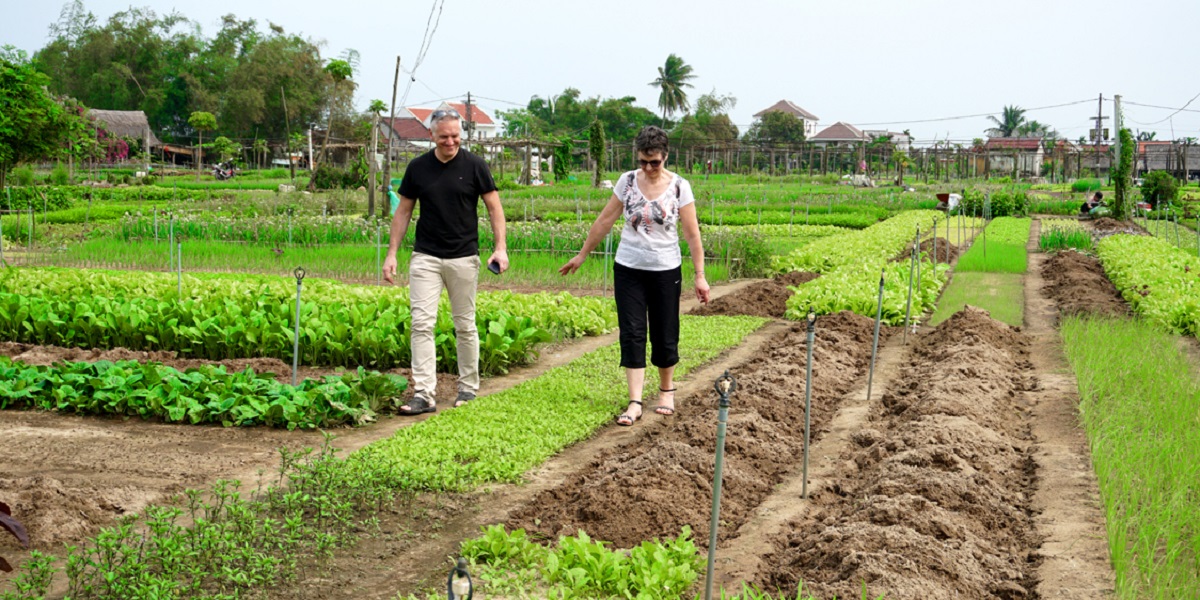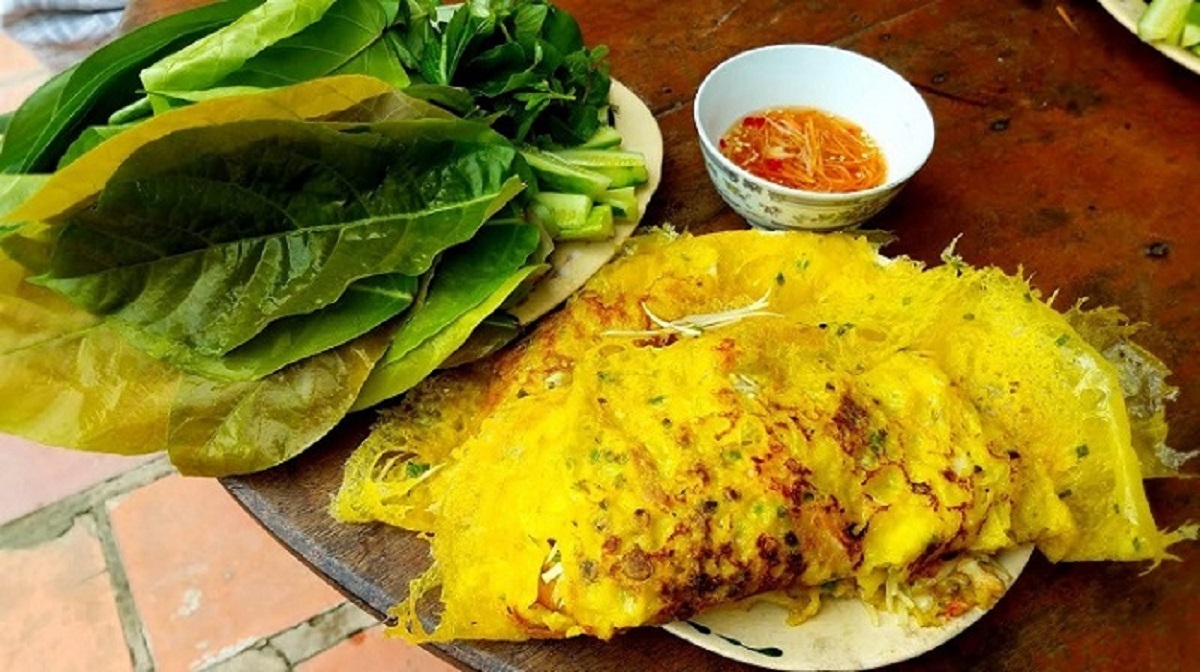Tra Que Vegetable Village, located in Cam Ha, Hoi An, has a history spanning hundreds of years. The village is renowned for producing delicious and well-known vegetables. The village spans about fifteen hectares, all of which are dedicated to safe and sustainable production methods.

Each year, the village attracts hundreds of thousands of visitors who are eager to learn about organic farming practices. They can participate in various activities such as land preparation, seed sowing, and irrigation.
Additionally, the village offers cooking classes where visitors can learn to prepare traditional Vietnamese dishes using fresh ingredients from the village’s garden, such as pho, rice paper, spring rolls, and salad rolls. One of the highlights is the hands-on experience of making rice paper from scratch, including grinding, rolling, and drying the rice mixture. This delicate rice paper is an essential component in popular dishes like salad rolls and spring rolls.

Hoi An is also famous for its beloved crispy pancakes, known for their golden, crispy exterior and savory filling of shrimp, pork, and bean sprouts. These pancakes are typically cut into small pieces and wrapped in rice paper, accompanied by fresh herbs, creating a delightful culinary experience.

Exploring the village by bicycle is another peaceful option, allowing visitors to soak in the tranquil atmosphere as they ride through the lush green fields and listen to the gentle breeze rustling through the trees. This experience truly captures the essence of Hoi An’s rustic charm and offers a sense of serenity that is hard to find in bustling cities.
Suggested Itinerary for a One-Day Tour of Tra Que Vegetable Village
You can customize your itinerary based on your preferences and time constraints. Even a one-day trip to Tra Que Vegetable Village can be immensely enjoyable, thanks to its pleasant weather, which features a dry season and a hot season, with temperatures rarely exceeding 33 degrees Celsius.
The village welcomes visitors all year round, and the entrance fee is very affordable, ranging from 20,000 to 30,000 VND per person. The locals are incredibly hospitable and always ready to lend a helping hand.
8:00 AM: Depart for Tra Que Vegetable Village.
9:00 AM: Begin your exploration of the village. If you’re part of a tour group, a guide will introduce you to the village and its history. Alternatively, you can interact with the friendly locals, who are more than happy to share their knowledge about the village’s history and culture.
9:30 AM: Engage in fun activities, take stunning photos, and actively participate in the vegetable production and care process. After the labor, relax and refresh yourself with a refreshing drink of Job’s tears seeds and a soothing foot bath using medicinal herbs.
12:00 PM: Enjoy a delicious lunch and take a well-deserved break.
1:00 PM: As your Tra Que Vegetable Village tour comes to an end, you have the option to explore the nearby Thanh Ha Pottery Village, located just a short distance away. Here, you’ll discover exquisite ceramic works, including replicas of world-famous landmarks. You can even try your hand at pottery-making under the guidance of skilled artisans.
4:00 PM: Conclude your tour of Tra Que Vegetable Village, having created memorable experiences and gained valuable insights into the local culture and traditions.
Take Part in the Village’s Grandest Festival
If you find yourself in the enchanting land of Quang Nam during the first month of the year, don’t miss the Hoi An Cau Bong Festival at Tra Que Vegetable Village. This unique festival embodies the cultural essence of the region and showcases the local community’s deep respect for their ancestors and spiritual beliefs.


The Hoi An Cau Bong Festival is held annually on the seventh day of the first lunar month at the Tien Hien Communal House. It is jointly organized by the village elders and local authorities, underscoring its significance to the people of Tra Que Vegetable Village.
A highlight of the festival is the community engagement and interaction facilitated through traditional folk games such as blindfolded pot-breaking, making soil for planting vegetables, displaying Tet holiday dishes, and performing martial arts. These activities foster a sense of unity and create a festive atmosphere that draws both locals and visitors alike.
Given the solemn nature of the festival, it is advisable to wear modest and respectful attire. By doing so, you demonstrate your appreciation for the local culture and customs.
A notable feature of the festival is the Tam Huu cooking contest, where participants showcase their skills in preparing a unique dish native to Tra Que Vegetable Village. Tam Huu is a delicious combination of shrimp, pork belly, and fresh mint, skillfully wrapped in blanched scallion leaves and served with a sweet and sour dipping sauce. The winning dish is chosen based on both taste and presentation.

When savored, Tam Huu offers a burst of flavors that can only be fully appreciated when enjoyed in the village itself, as the ingredients are sourced directly from the fertile lands of Tra Que.

To immerse yourself completely in the festival atmosphere, consider renting an ao dai, the traditional Vietnamese long dress. You can find rental services near the festival venue, offering a variety of styles and colors to choose from.
Keep in mind that the Hoi An Cau Bong Festival starts early in the day, so plan your arrival time accordingly to ensure you don’t miss any of the captivating rituals and festivities.
|
Tra Que Vegetable Village is a renowned attraction in Hoi An, nestled like an oasis surrounded by the Co Co River, fields, and natural canals en route from the beach to the ancient town. The locals have traditionally practiced manual cultivation methods, minimizing the use of chemical fertilizers. What sets Tra Que apart is the distinctive fragrance of its herbs, more potent and aromatic than those grown elsewhere. The village boasts a concentrated vegetable farming area spanning approximately 40 hectares. Each household is allocated land based on their family size. They cultivate over 40 varieties of vegetables, supplying hotels and restaurants in Da Nang and Hoi An, as well as major supermarkets. Since 2020, ticket sales and investments have been managed by a business entity in Hoi An. The village attracts 20,000 to 30,000 visitors annually. With Tra Que Vegetable Village recognized as one of the best tourism villages globally, Hoi An is further motivated to pursue its vision of becoming a cultural, ecological, and environmentally friendly city. This achievement is a testament to the collective efforts of the community and local government in preserving the peaceful, rustic, and welcoming spirit of Hoi An. Hoi An continues to excel in various tourism-related rankings, reflecting its enduring appeal as a beloved destination. |



































